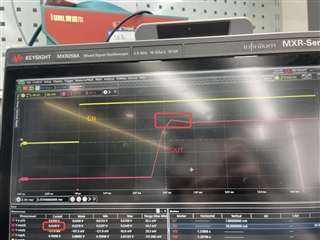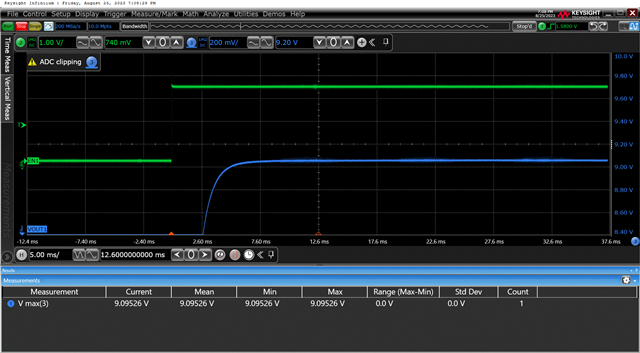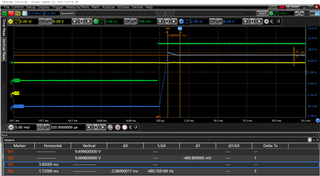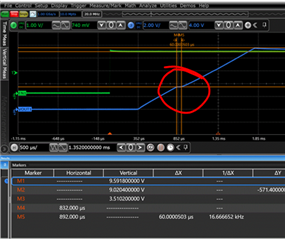We set VOUT=9V, VIN=12V. We find that VOUT will exceed 9V during start up and go back to 9V later, which is shown below:

If we set VOUT=5V and VIN=12V, this phenomenon will disappear.
My question is why it will exceed set value when VOUT=9V?
This thread has been locked.
If you have a related question, please click the "Ask a related question" button in the top right corner. The newly created question will be automatically linked to this question.
We set VOUT=9V, VIN=12V. We find that VOUT will exceed 9V during start up and go back to 9V later, which is shown below:

If we set VOUT=5V and VIN=12V, this phenomenon will disappear.
My question is why it will exceed set value when VOUT=9V?
Hi Wang,
I suspect you are turning on into dropout. Try enabling the device after VIN has reached steady state to see if this fixes the overshoot.
https://www.ti.com/lit/an/sbva060/sbva060.pdf
Thanks,
Stephen
Hi,
We checked VIN and found that EN was pulled high while VIN was not stable. To fix it, we delay EN and the waveforms are shown below.It seems that it hit the current limit during start-up. We are confused why it will rise to 9.7 V and go back to 9V after 70ms. The transition from dropout to normal operation is so long?


Hi Wang,
Can you provide a schematic? Can you also confirm that you are measuring Vout during turn on at the point of regulation (I.E. across the feedback resistors to GND)?
Once the LDO has charged up Cout beyond the setpoint (9V) and the feedback detects that, the internal error amplifier will turn off the pass device. The output capacitance will then be discharged with whatever leakage or loading exist in the system. The 70ms is how long your circuitry takes to discharge the output capacitance. If you add a small preload to the LDO you will see the output discharge faster.
Thanks,
Stephen
Hi,
1. We add VFB and it goes up to 1.32V.

2. SCH
It is confidential. I can send it to you by e-mail
3. Since it hits currrent limit during start-up and it enters by-pass mode, why VOUT isn't equal to VOUT? VOUT increases to 9.7V , which seems MOSFET is not fully on during current limit?
Hi Wang,
These are good questions but it will be easier to answer them if I can see the schematic. Can you send it to me over email? I have sent you a friend request, which once accepted will allow us to communicate over email.
Thanks,
Stephen
Hi Wang,
Can you try adding feed forward capacitors (Cff) across the top setpoint resistors (R1448 and R1400)? I would try 1nF or 10nF to see if that delays the turn on enough to eliminate the overshoot. The Cff has other benefits, please see this app note for details.
https://www.ti.com/lit/an/sbva042/sbva042.pdf
Thanks,
Stephen
Hi,
1. If we add Rload without Cff, overshoot still exists. However the discharge time decreases to 2ms.
P.s. We measured 70ms due to open load.

2. If we add Cff=1nf and find the overshoot decreases to 9.14V

If we add Cff=10nf, the overshoot disappears.

So adding Cff can help reduce overshoot.
It seems ok to us now. Thanks very much!!! But we still have two extra questions.
Q1: Since it hits currrent limit during start-up and it enters by-pass mode, why VOUT isn't equal to VOUT? VOUT increases to 9.7V, which seems MOSFET is not fully on during current limit.
Q2: Sometimes Vout reaches to 3.5V and stays for 60us, then continues rising. (With Rload, without Cff) Why does it stop rising during star-up phase?

Hi Wang,
Can you remind me again on why you believe this device enters bypass mode? This LDO can enter current limit but this does not mean it is acting like a load switch, where Vout = Vin - dropout.
For your second question on Vout pausing the turn on around 3.5V: can you show a scope shot of this with EN, Vout and also Vin?
Thanks,
Stephen
1. It seems I misunderstood current limit and drop-out mode. I read from the file you shown below, which you sent to me. I ignored the conditon 'When the VIN is unable to drive the output to the set voltage'. In our test, VIN is always stable and it doesn't meet the description marked green. So during current-limit at start-up phase, what does MOSFET act like if VIN is always stable?

2. FYI

Hi Wang,
During startup the pass device is in saturation.
For the second question, I was hoping to see the EN voltage plotted with this data where the Vout pauses turn on briefly:

Thanks,
Stephen
Okay thanks Wang, I did not realize that Vin = Ven in that plot. I have not personally seen this behavior before where Vout pauses momentarily during turn on. Let me ask some of the other engineers if they have seen this and I'll get back to you.
Thanks,
Stephen
Hi Wang,
We have not seen this behavior before with this device, although on a few of our other LDO's we have seen similar behavior and in those devices this is related to the internal soft start circuitry. We would have to run simulations to know for certain if this behavior is related to the internal soft start circuitry inside the TPS7B7702-Q1. If so, it sounds like there would be nothing we can do externally to improve this behavior although it appears to be just a "pause" during turn on, and not something that is showing non-monotonic behavior. If we wanted simulations it will take 3-4 weeks as our IC design team has a long line of requests they are working through right now. Let me know what you would like to do.
Thanks,
Stephen